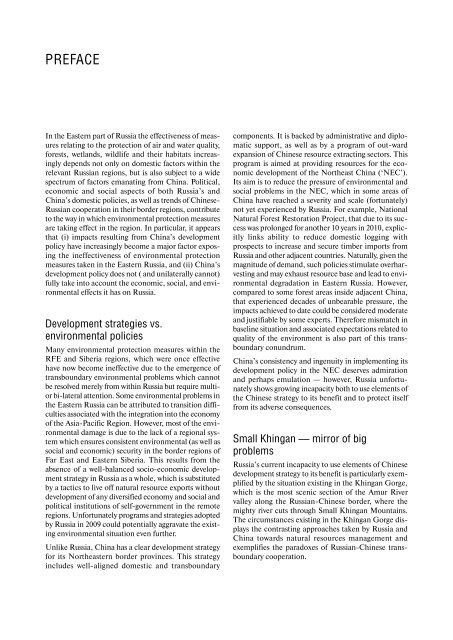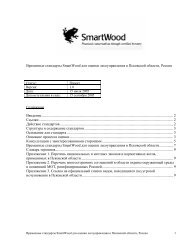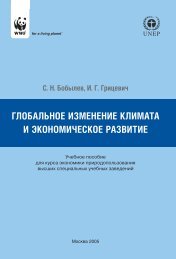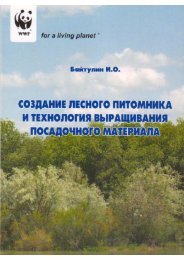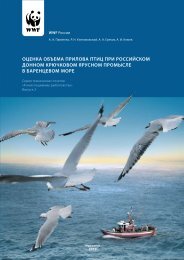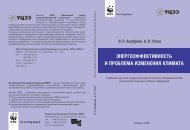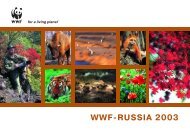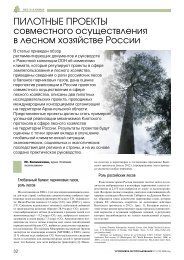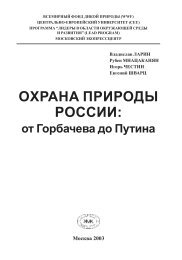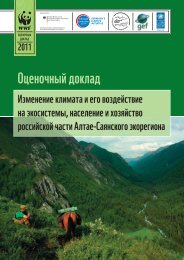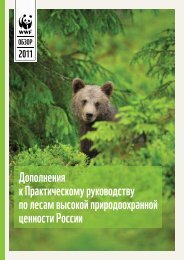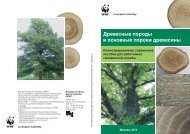to sino- russian
to sino- russian
to sino- russian
You also want an ePaper? Increase the reach of your titles
YUMPU automatically turns print PDFs into web optimized ePapers that Google loves.
PREFACE<br />
In the Eastern part of Russia the effectiveness of measures<br />
relating <strong>to</strong> the protection of air and water quality,<br />
forests, wetlands, wildlife and their habitats increasingly<br />
depends not only on domestic fac<strong>to</strong>rs within the<br />
relevant Russian regions, but is also subject <strong>to</strong> a wide<br />
spectrum of fac<strong>to</strong>rs emanating from China. Political,<br />
economic and social aspects of both Russia’s and<br />
China’s domestic policies, as well as trends of Chinese-<br />
Russian cooperation in their border regions, contribute<br />
<strong>to</strong> the way in which environmental protection measures<br />
are taking effect in the region. In particular, it appears<br />
that (i) impacts resulting from China’s development<br />
policy have increasingly become a major fac<strong>to</strong>r exposing<br />
the ineffectiveness of environmental protection<br />
measures taken in the Eastern Russia, and (ii) China’s<br />
development policy does not ( and unilaterally cannot)<br />
fully take in<strong>to</strong> account the economic, social, and environmental<br />
effects it has on Russia.<br />
Development strategies vs.<br />
environmental policies<br />
Many environmental protection measures within the<br />
RFE and Siberia regions, which were once effective<br />
have now become ineffective due <strong>to</strong> the emergence of<br />
transboundary environmental problems which cannot<br />
be resolved merely from within Russia but require multior<br />
bi-lateral attention. Some environmental problems in<br />
the Eastern Russia can be attributed <strong>to</strong> transition difficulties<br />
associated with the integration in<strong>to</strong> the economy<br />
of the Asia-Pacific Region. However, most of the environmental<br />
damage is due <strong>to</strong> the lack of a regional system<br />
which ensures consistent environmental (as well as<br />
social and economic) security in the border regions of<br />
Far East and Eastern Siberia. This results from the<br />
absence of a well-balanced socio-economic development<br />
strategy in Russia as a whole, which is substituted<br />
by a tactics <strong>to</strong> live off natural resource exports without<br />
development of any diversified economy and social and<br />
political institutions of self-government in the remote<br />
regions. Unfortunately programs and strategies adopted<br />
by Russia in 2009 could potentially aggravate the existing<br />
environmental situation even further.<br />
Unlike Russia, China has a clear development strategy<br />
for its Northeastern border provinces. This strategy<br />
includes well-aligned domestic and transboundary<br />
components. It is backed by administrative and diplomatic<br />
support, as well as by a program of out-ward<br />
expansion of Chinese resource extracting sec<strong>to</strong>rs. This<br />
program is aimed at providing resources for the economic<br />
development of the Northeast China (‘NEC’).<br />
Its aim is <strong>to</strong> reduce the pressure of environmental and<br />
social problems in the NEC, which in some areas of<br />
China have reached a severity and scale (fortunately)<br />
not yet experienced by Russia. For example, National<br />
Natural Forest Res<strong>to</strong>ration Project, that due <strong>to</strong> its success<br />
was prolonged for another 10 years in 2010, explicitly<br />
links ability <strong>to</strong> reduce domestic logging with<br />
prospects <strong>to</strong> increase and secure timber imports from<br />
Russia and other adjacent countries. Naturally, given the<br />
magnitude of demand, such policies stimulate overharvesting<br />
and may exhaust resource base and lead <strong>to</strong> environmental<br />
degradation in Eastern Russia. However,<br />
compared <strong>to</strong> some forest areas inside adjacent China,<br />
that experienced decades of unbearable pressure, the<br />
impacts achieved <strong>to</strong> date could be considered moderate<br />
and justifiable by some experts. Therefore mismatch in<br />
baseline situation and associated expectations related <strong>to</strong><br />
quality of the environment is also part of this transboundary<br />
conundrum.<br />
China’s consistency and ingenuity in implementing its<br />
development policy in the NEC deserves admiration<br />
and perhaps emulation — however, Russia unfortunately<br />
shows growing incapacity both <strong>to</strong> use elements of<br />
the Chinese strategy <strong>to</strong> its benefit and <strong>to</strong> protect itself<br />
from its adverse consequences.<br />
Small Khingan — mirror of big<br />
problems<br />
Russia’s current incapacity <strong>to</strong> use elements of Chinese<br />
development strategy <strong>to</strong> its benefit is particularly exemplified<br />
by the situation existing in the Khingan Gorge,<br />
which is the most scenic section of the Amur River<br />
valley along the Russian-Chinese border, where the<br />
mighty river cuts through Small Khingan Mountains.<br />
The circumstances existing in the Khingan Gorge displays<br />
the contrasting approaches taken by Russia and<br />
China <strong>to</strong>wards natural resources management and<br />
exemplifies the paradoxes of Russian-Chinese transboundary<br />
cooperation.


